
Credit: Miguel J. Rodríguez Carrillo/Getty Images
Privately owned Blue Origin has achieved its goal—a decade in the making—of becoming an orbital launch player, even as it failed to recover its first-stage booster in the ambitious inaugural flight of its New Glenn rocket on its NG-1 mission. The 321-ft.-tall rocket took off at 2:03 a.m. EST from...
Blue Origin Reaches Orbit In New Glenn Inaugural Mission is available to both Aviation Week & Space Technology and AWIN subscribers.
Subscribe now to read this content, plus receive critical analysis into emerging trends, technological advancements, operational best practices and continuous updates to policy, requirements and budgets.
Already a subscriber to AW&ST or AWIN? Log in with your existing email and password.





